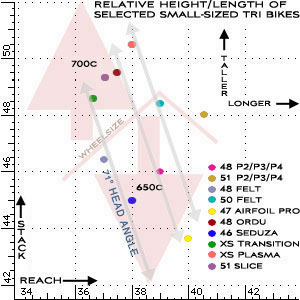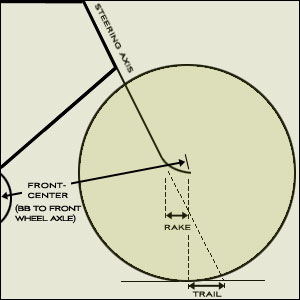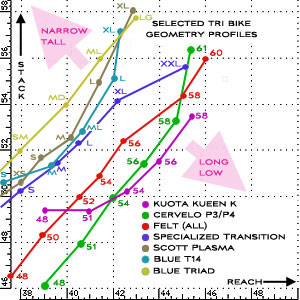Small bike sizing comparison

There is a lot going on with this chart. Please pardon for trying to get the biggest bang for my 300 pixels square.
Are you 5'6" or shorter, or have an interest in one who is? Then, let's try to make some hay. You'll notice a "wheelsize" line—sort of an inverted L—and it would be nice and clean straight horizontal line were it not for a 50cm Felt sticking up there near that L's fulcrum. Felt chooses to make two sizes in 650c, its 48cm and its 50cm. Outside of that 50cm Felt, note that all the 650c bikes are lower—that is, they have less stack—than the 700c bikes.
Yet all these bikes—the taller as well as the lower bikes on this chart—are made for small riders. There is a built-in disability, or inability, to make a "low" bike, if you build that bike with 700c wheels. Generally, the cut-off is at about 48cm of stack. It's just about impossible to make a bike lower than that with 700c wheels. If you don't need a stack lower than 48cm, then a 700c wheeled bike will work for you. Otherwise, it takes some work to get that bike low enough.
In 650c, you have bikes made with as low as 43.7cm of stack. That's the Kestrel Airfoil Pro, the lowest bike on the planet. If you're really tiny, then, this might be a good bike for you. Note that it's a bit longish, tho.
But let's talk for a moment about low bikes that are stacked up with spacers. If you've got a low bike with 3cm, 4cm, or 5cm of spacers, then you've got the functional equivalent of a taller, narrower bike, except, with less bike and more spacers. That's the point of these gray lines tilted at a 71° bias. This is a fairly common head angle for bikes of this size.
Note that a a 46cm QR Seduza has a stack of 45cm. It's a great bike for gals and guys shorter than 5'6". But a Specialized Transition in size XS, and a 48cm Felt, sit along that same bias. So, if that Seduza was a bit low for you and you had to stack it up with headset spacers, what you really bought was less bike and more spacers, rather than more bike and fewer spacers.
Likewise the 47cm Kestrel Airfoil Pro and the 48cm Cervelos. If you need the "lowness" of the Kestrel, there it is, waiting for you. But if your Kestrel has 4cm of spacers under the stem, that's just about a geometric match for a Cervelo in 48cm with 1cm of spacers under the stem, which I believe is the clear preference. Likewise, the Cervelo with 4cm under the stem is an Orbea Ordu with 1cm or 2cm under the stem.
This exercise has a practical limit, however. If you keep spacing an already small bike up higher and higher, nobody is built with a morphology that'll match that bike. With this exception: If a rider sits back at a slacker seat angle. For this reason, the Ordu is probably a better choice than a P3 if the rider rides slack.
Likewise the 50cm Felt and the XS size of the Scott Plasma sit along that same head angle bias. You'll probably ride that Felt with very few spacers if you ride fairly steep. But if you ride shallow, you might need to stack up that Felt with spacers to get the bar high enough. If that 50cm Felt fit you perfectly, with an 8cm stem, and 4cm of spacers under the stem, it might be better for you to just choose the Scott Plasma in XS.
There are, of course, more to bikes than simply the number of spacers under the stem. Some of these 700c bikes are pretty long in the wheelbase and/or have clumsier steering because of the very shallow head angles and the large trail numbers (remember, all the bikes on this chart are size-XS or circa-48cm). That's why 650c is generally preferential for riders 5'5" and smaller.
But, in general—and this refers to any bike in every size—the bike's head tube should sit no more than 25mm below the bottom of the stem clamp. That is to say, if you measure from the head tube top up to the stem bottom, the accumulated height of spacers plus headset top cap should not exceed 25mm for optimal fit, handling and aerodynamics. If it does, the bike strays from ideal, and, there's probably a bike along that head tube angle bias that fits up underneath your stem.
The converse is true. If you can't get a bike low enough, then, you've chosen a bike that's too tall. The bike-that's-too-tall problem tends to be more prevalent among riders between 4'10" and 5'5".



